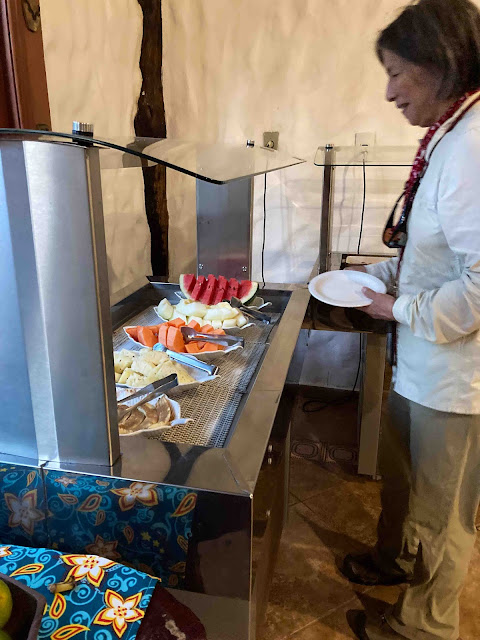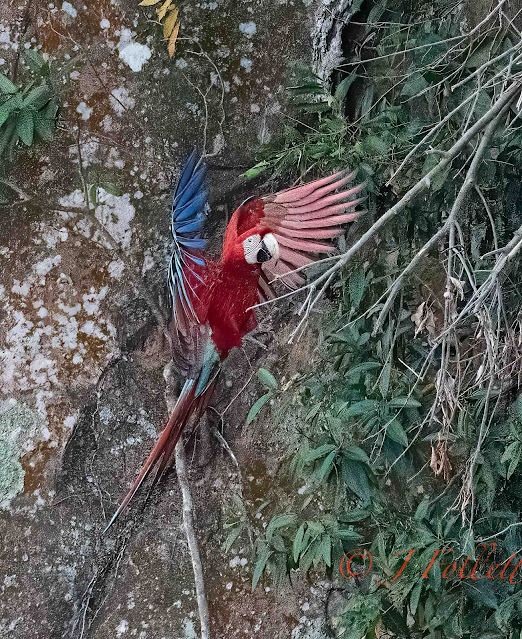(To see photos full screen, click on one and then scroll through them.)
Chapter Eight
The Sinkhole
I hope you love birds too. It is economical.
It saves going to heaven.
—Emily Dickinson
 The ladies who run the kitchen at Hotel Cabanas come to work early just so we can have breakfast at 5-ish and be on our way to a special place. It’s about a 30-minute drive and we leave in darkness.
The ladies who run the kitchen at Hotel Cabanas come to work early just so we can have breakfast at 5-ish and be on our way to a special place. It’s about a 30-minute drive and we leave in darkness.
 |
| Just a small part of the large buffet for breakfast. |
Buraco das Araras is the name of this private property that has been turned into an attraction so that thousands of people can marvel over the birds that live there. Rediscovered in 1912, the sinkhole is now part of the 29-hectares Buraco das Araras Private Natural Heritage Reserve.
Buraco das Araras means, literally, Hole of the Macaws.
We register at the greeting center (I guess if we don't return, they'll assume we fell in the sinkhole) and begin a ten-minute walk through the woods. I'm lagging behind and suddenly red and green macaws are flying over my head so closely I feel the movement of air and duck.
Local legend has it that cattle thieves and other miscreants that the locals wanted rid of would be blindfolded and driven to this area. They would be untied, blindfolds still in place, and told they were free—run! Of course they would run in the opposite direction of the lawmen and right into the sinkhole.
We come to a two-story platform with high railings overlooking a 330-foot deep sandstone crater that is 1640-feet in circumference, and more than 522 feet in diameter.
 |
| Photo taken after the tourists arrived. Hence the arm in the photo. |
A short video of the sinkhole.
At the bottom is a small green pond that is the natural water table in this area.
Broad-snouted caimans live at the bottom and their survival is thought to be because they eat their young, there being no other food in the crater.
And so begins the most challenging photography I have ever encountered. Half in sunlight, half in shadow, my camera's auto-ISO is all over the place and mostly way too high. Bird in light with darkness in the background, or the other way around.
I take photos of perched birds first, then try my luck at flying birds.
To do that, I have to lift my camera above the top guard rail and lean it out. Now I’m afraid I’ll drop the camera into the abyss.
 |
| This railing is way too high for me to lean my camera over, as you can see by this photographer who is a bit taller than me. I had to stand on a step stool. |
The day heats up quickly and soon I’m taking frequent breaks on a bench and gulping water.
I should have done what Shelly did—ask Octavio questions right off the bat.
At length he comes over to see how I’m doing and when I tell him “not very well” he takes my camera and changes the auto-focus settings. That helps a lot and long after this trip is over, those settings remain on my camera.
Rather than a tiny rectangle to try to place on a flying bird, I now have a larger rectangle and need only get part of the bird within that rectangle. It gives me a fighting chance and enables me to get bird-in-flight photos throughout the trip.
There’s still the flying bird thing. They might look like they’re just drifting along, but try to track them with your long lens and they might as well be Secretariat at Churchill Downs, except that famous horse wasn’t constantly in and out of changing light.
Eventually, I get something approximating a decent, though not great, image but by then I am exhausted from the heat.
These photos are not all from this first day.
A bunch of non-photographers arrive and we leave. It's almost lunch time anyway.
Last evening, we drove the backroads around pastures, looking for giant anteaters. Octavio spotted brown shapes that were barely visible above the dried grasses.
I took a couple shots. I thought they were boulders but after down-loading and looking at them on a computer screen, I can see the long brown hair of anteaters.
 |
| Are they or aren't they giant anteaters? |
 |
| A mated pair: red and green macaw and blue and yellow macaw. |
 |
| Making baby macaws. |

 |
| The same mated pair. |
 |
| Red and green macaws |
 |
| Buff-necked ibis |
 |
| Plumbeous ibis. |






















Well a Good Early Morning to you Gullible here at just past midnight on Sunday, November the 5th. Gullible we never knew this.. Buraco das Araras means, literally, Hole of the Macaws. Live and Learn huh? They are certainly beautiful birds. Like Parrots? Macaws are a group of New World parrots that are long-tailed and often colorful. What a challenge .. And so begins the most challenging photography I have ever encountered. Lots of Smiles .. Cap and Patti
ReplyDelete